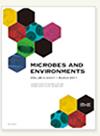木麻黄小泡包膜发育缺陷突变体的研究。
IF 2
4区 环境科学与生态学
Q3 BIOTECHNOLOGY & APPLIED MICROBIOLOGY
引用次数: 0
摘要
法兰克菌是一种固氮放线菌,它形成了一种独特的多细胞结构,称为囊泡,专门用于固氮。囊泡被一层厚的类hopanoid脂质包膜包围,作为氧气渗透的屏障,防止氮酶失活。五个突变体产生的囊泡数量与野生型相似;然而,他们没能固定N2。5个突变体的囊泡膜厚度均减小,囊泡内氧浓度升高。因此,这些突变体由于氧气渗透到囊泡中引起的氮酶失活而无法固定N2。本文章由计算机程序翻译,如有差异,请以英文原文为准。
Characterization of Frankia casuarinae Mutants Defective in Vesicle Envelope Development.
Frankia, a nitrogen-fixing actinobacterium, forms a unique multicellular structure known as a vesicle that is dedicated to nitrogen fixation. The vesicle is surrounded by a thick hopanoid lipid envelope that acts as a barrier against oxygen penetration, preventing nitrogenase inactivation. Five mutants produced a similar number of vesicles to the wild type; however, they failed to fix N2. The thickness of vesicle envelopes was reduced in all five mutants, and the oxygen concentration increased inside the vesicles of four mutants. Therefore, these mutants were unable to fix N2 due to the inactivation of nitrogenase caused by oxygen penetration into the vesicles.
求助全文
通过发布文献求助,成功后即可免费获取论文全文。
去求助
来源期刊

Microbes and Environments
生物-生物工程与应用微生物
CiteScore
4.10
自引率
13.60%
发文量
66
审稿时长
3 months
期刊介绍:
Microbial ecology in natural and engineered environments; Microbial degradation of xenobiotic compounds; Microbial processes in biogeochemical cycles; Microbial interactions and signaling with animals and plants; Interactions among microorganisms; Microorganisms related to public health; Phylogenetic and functional diversity of microbial communities; Genomics, metagenomics, and bioinformatics for microbiology; Application of microorganisms to agriculture, fishery, and industry; Molecular biology and biochemistry related to environmental microbiology; Methodology in general and environmental microbiology; Interdisciplinary research areas for microbial ecology (e.g., Astrobiology, and Origins of Life); Taxonomic description of novel microorganisms with ecological perspective; Physiology and metabolisms of microorganisms; Evolution of genes and microorganisms; Genome report of microorganisms with ecological perspective.
 求助内容:
求助内容: 应助结果提醒方式:
应助结果提醒方式:


